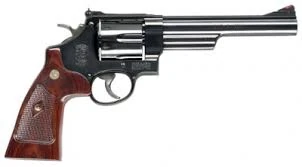
The Smith & Wesson Model 29 is a six-shot, double-action revolver chambered for the .44 Magnum cartridge and manufactured by the U.S. company Smith & Wesson. It was made famous by — and is still most often associated with — the fictional character "Dirty Harry" Callahan from the Dirty Harry series of films starring Clint Eastwood. It was used by Billy Rosewood in Beverly Hills Cop II, earning him the nickname "Dirty Rosewood".
Description[]
The Model 29 was offered with 3", 4", 5", 6", 6½", 8⅜" and, later, 10⅝" barrel lengths as standard models. Other barrel lengths were available either by special order from Smith & Wesson's Custom Shop or custom built by gunsmiths. The 5" barreled variant had a full length underlug. Finish options available included a highly polished blued or nickel-plated surface.
S&W's production of a large N-frame revolver in .44 Magnum began in 1955; the Model 29 designation was applied in 1957.[1] It remained primarily the province of handgun enthusiasts, some law enforcement personnel and hunters until 1971, when Clint Eastwood made it famous as "the most powerful handgun in the world" in the movie Dirty Harry. After the movie's release, retailers had trouble keeping the Model 29 in stock.
At the time of its introduction, the Model 29 was the most powerful production handgun. There were a number of custom, or wildcat, calibers that were more powerful, as in the old Howdah pistols of the 19th century. Elmer Keith's achievements in maximizing the power and performance of the .44 Special was the inspiration and driving force behind the introduction of the .44 Magnum by Smith & Wesson. His intention for the new round was for it to be used in sidearms for hunters of large, dangerous game, rather than for self-defense, though with today's specialty cartridges, it can be a good defensive round.
The Model 29 will chamber and fire .44 Special cartridges, as the .44 Magnum was developed from the .44 Special. The Magnum case is slightly longer to prevent magnum rounds from being chambered and fired in handguns chambered for the .44 Special.
In the late 1990s, Smith and Wesson discontinued production of many models of revolvers, including the 'basic' Model 29; since then, at various times, the model, in limited or 'custom' configurations, has been manufactured in as many as 10 evolutions.
